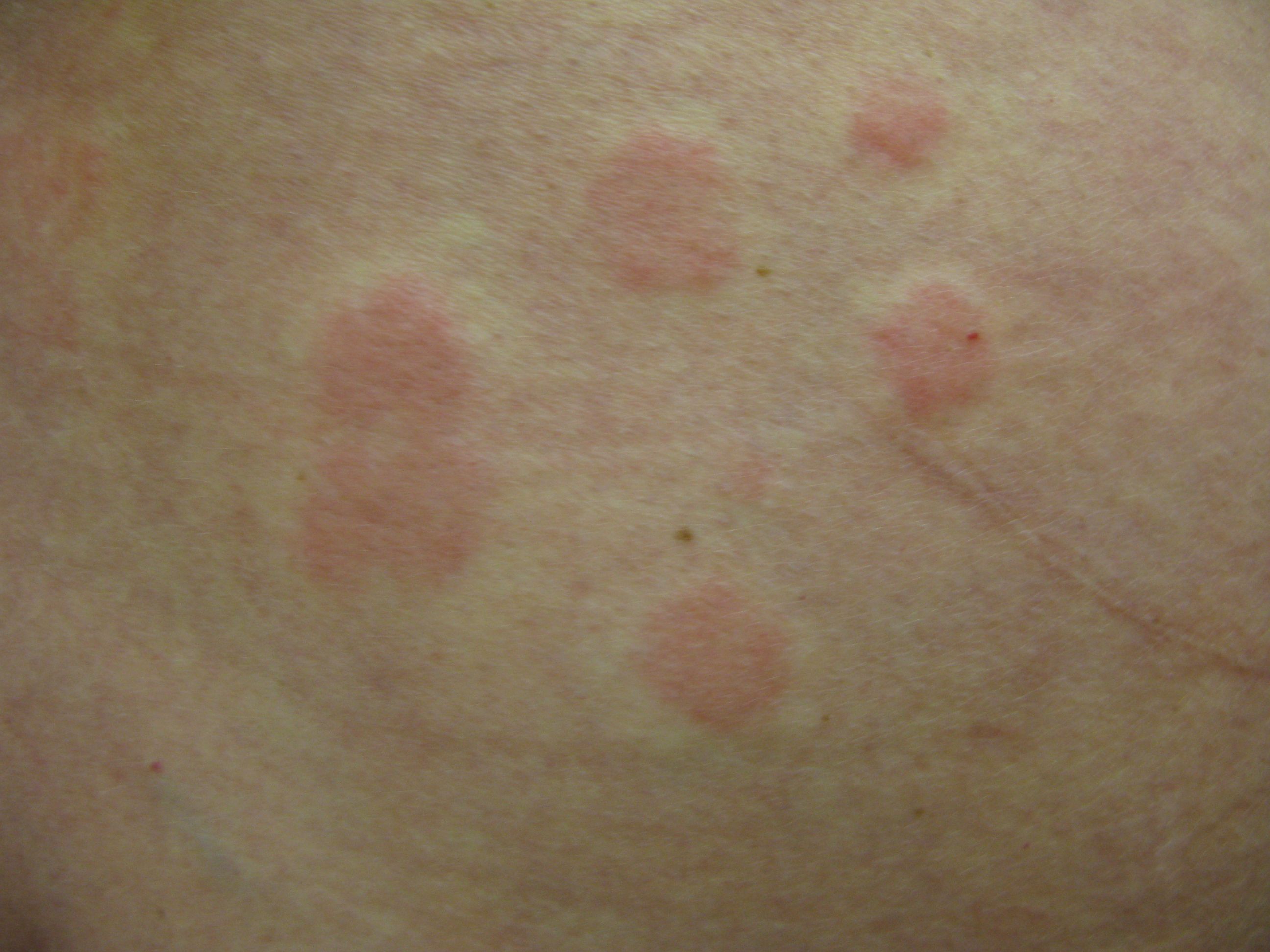- Acne
- Actinic Keratosis
- Aesthetics
- Alopecia
- Atopic Dermatitis
- Buy-and-Bill
- COVID-19
- Case-Based Roundtable
- Chronic Hand Eczema
- Chronic Spontaneous Urticaria
- Drug Watch
- Eczema
- General Dermatology
- Hidradenitis Suppurativa
- Melasma
- NP and PA
- Pediatric Dermatology
- Pigmentary Disorders
- Practice Management
- Precision Medicine and Biologics
- Prurigo Nodularis
- Psoriasis
- Psoriatic Arthritis
- Rare Disease
- Rosacea
- Skin Cancer
- Vitiligo
- Wound Care
Article
Tips for diagnosing, treating urticaria
Author(s):
Physician assistants (PAs) and nurse practitioners (NPs) in dermatology often encounter patients with urticaria and need to know how to distinguish acute and chronic conditions. Joseph C English III, M.D. provided his insight on urticaria and utrticaria-like eruptions at the Society of Dermatology Physician Assistants (SDPA) annual conference. Participate in this forum.
Urticaria. (Photo courtesy of Joseph C English III, M.D.)

Joseph C English III, M.D., professor of dermatology at the University of Pittsburgh

Physician assistants (PAs) and nurse practitioners (NPs) in dermatology need to be able to distinguish acute from chronic urticaria and look into what is causing the hives and consider urticaria-like eruptions as differentials, according to Joseph C English III, M.D., professor of dermatology at the University of Pittsburgh.
ACUTE URTICARIA AND HOW TO TREAT IT
Acute hives usually are of new onset and transient in nature.
“They might come and go at different body sites and don’t last longer than 24 hours,” says Dr. English, who presented on urticaria and urticaria-like eruptions at the Society of Dermatology Physician Assistants (SDPA) annual fall conference in October 2018.
Acute urticaria generally is very pruritic and usually does not have a burning sensation.
It’s important that dermatology providers consider that acute urticaria might be associated with angioedema and anaphylaxis. Angioedema tends to be a deeper swelling that affects the eyes and mouth and, in some cases, may cause laryngeal edema with airway compromise. If it associated with a drop of systolic blood pressure, anaphylaxis is occurring. That’s a medical emergency, Dr. English says.
“The patient with acute hives and angioedema can be stable-not having to worry about a life-threatening process. But you have to be aware that the angioedema can progress if the reaction is excessive,” he says.
The standard first-line treatment for acute urticaria is an oral antihistamine-the non-sedating type during the day and sedating during the night.
“Depending on how extensive the eruption is, you could also prescribe a prednisone taper. Usually it requires at least a 21-day taper, roughly 1mg per kg per day dosing,” Dr. English says. “Often, non-dermatologists will give these patients a methylprednisolone dose pack or short course of oral prednisone for only three or four days. That’s usually not enough. The patient will have significant rebound hives after these short pulse steroids if they don’t do a full 21 days.”
For angioedema and severe cases in which patients experience airway compromise in the office, dermatology providers might administer injectable epinephrine before sending patients to the emergency room. But most severe cases occur outside the office and patients go directly to the emergency department where they’ll be treated with epinephrine, intravenous (IV) methylprednisolone and IV diphenhydramine, according to Dr. English.
Urticaria patients who have experienced angioedema or anaphylaxis need to have personal injectable epinephrine to carry with them, he says.
CHRONIC HIVES AND OPTIMAL TREATMENT
The lesions of chronic urticaria look like those in acute hives. But in chronic urticaria patients have lesions recurring and persisting for six to eight weeks or more.
“The lesions are still migratory, coming and going at different sites and lasting for less than 24 hours. Usually they’re pruritic more than they burn,” Dr. English says.
The issue with chronic urticaria is attempting to find the cause and, unfortunately, most people suffering from chronic spontaneous urticaria don’t find the allergen that’s causing the problem.
But there are two subtypes that can help determine what’s going on, according to Dr. English.
“One is chronic autoimmune thyroiditis and the other is chronic autoimmune urticaria,” he says.
Dr. English says his workup for chronic urticaria patients includes checking for thyroid antibodies and thyroid function. He also does a histamine release assay, or chronic urticarial index, which helps determine if a patient has a form of autoimmune urticaria that’s not related to thyroiditis.
“It’s not so much that this information changes your management of the hives or determines if the patient is going to have a more chronic course, but the chronic urticaria index at least offers the patient and provider an answer about the source of the urticaria,” he says.
Dr. English recommends a biopsy and direct immunofluorescence to rule out other urticarial dermatoses: urticarial vasculitis, urticarial dermatitis (dermal hypersensitivity reaction), or prodromal or urticarial bullous pemphigoid, especially if lesions are not migratory.
Schnitzler’s syndrome is an extremely rare form of chronic urticaria associated with bone pain and paraproteinemia. So, in patients with chronic urticaria who have bone pain symptoms, Dr. English will check a serum immunofixation electrophoresis and serum free light-chain just to see if they have an abnormal protein. Schnitzler’s is more difficult to treat, he says.
Dr. English’s treatment of chronic urticaria starts with antihistamines and a leukotriene inhibitor, such as montelukast.
“Often you have to go to immunosuppressant therapy, which is variable and depends on what you feel more comfortable with and what’s appropriate due to the patient’s medical history and current oral medications. Mycophenolate mofetil, azathioprine, cyclosporine, sulfasalazine and dapsone are all good second-line therapies to try,” he says. “If that fails, you can move to the biologics. Most insurance companies require you to fail a primary line of suppression before you get to the more expensive line of biologics.”
Dr. English says the biologic he usually prescribes for urticaria is omalizumab, a monoclonal anti immunoglobulin E (IgE) antibody.
He cites a metanalysis published January 2019 in JAMA Dermatology looking at benefits and harms of omalizumab treatment in adolescent and adult chronic idiopathic urticaria.
“In this meta-analysis of 67 published reports on real-world effectiveness, omalizumab therapy was associated with an average 25.6-point improvement in weekly Urticaria Activity Score (vs a 14.9 to 22.1 point improvement reported in clinical trials), a 4.7 point improvement in Urticaria Activity Score, a complete response rate of 72.2%, a partial response rate of 17.8%, and an average adverse event rate of 4.0% (vs 2.9%-8.0% reported in clinical trials),” according to the paper’s key findings.
For patients resistant to omalizumab, Dr. English says he’ll initiate his third-line therapy for chronic urticaria intravenous immunoglobulin (IVIG).
DIFFERENTIAL DIAGNOSES
An important question to ask when assessing chronic hives is: Are the lesions fixed or do they migrate?
“Urticarial vasculitis and urticarial dermatoses are not hives. They like to be fixed and stay in the same place longer than 24 hours. Lesions can have a tendency to burn more than being pruritic,” Dr. English says.
Differentiating the lesions will determine one’s workup.
Autoimmune bullous disorders are also a possibility, according to Dr. English
“For example, if the patient is pregnant with an urticarial eruption or a hive-like eruption, there are different diagnoses for that. One is in the second trimester patients can get pemphigoid gestationis; later in the third trimester they can get polymorphic eruption of pregnancy. Those diseases have different outcomes, so it’s important to differentiate them.”
“Prodromal bullous pemphigoid can mimic chronic urticaria and, which often requires differentiation especially in urticarial dermatoses in the elderly,” he says.
ODDS AND ENDS
More biologic options might be on the horizon for these patients. Researchers are conducting studies on second generation anti IgE antibodies, according to Dr. English, but they are still in clinical trials.
Dr. English says one trend in the treatment of urticaria patients is for the dermatology practice to perform radioallergosorbent (RAST) IgE testing looking for food, mold, grass, tree, mite, animal dander and other allergens.
“Normally you might not do it in dermatology practice but can be helpful in identifying a possible triggering antigen,” Dr. English says.

Newsletter
Like what you’re reading? Subscribe to Dermatology Times for weekly updates on therapies, innovations, and real-world practice tips.














